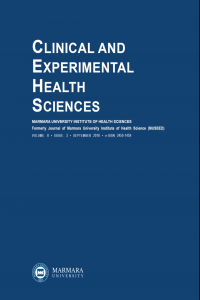Abstract
References
- World Health Organization (WHO). Ultraviolet Radiation and the INTERSUN Program. http://www.who.int/uv/faq/skincancer/en/index1. html Retrieved from: 22/04/2014, 2012
The Impact of Sun Protection Program on the Sun Protection Behavior of Adolescents
Abstract
Background: The incidence of skin cancers is steadily increasing. In particular,
because children and adolescents tend to be outdoors during the hours of most
intensive sunlight, schools play an important role in establishing sun protection
behavior among students.
Purpose: The aim of this research was to investigate the effect of a Sun Protection
Program (SPP) on the sun protection behavior of Turkish adolescents.
Methods: This study was designed as pre-/posttest control group semi-experimental
research. The research was carried out with 147 12-15 years-old adolescents in two
schools. One of the schools was randomly designated as consisting of the intervention
group of students; the other represented the control group. The intervention group
comprised 76, the control group 71 students, which together made up the sample.
Covariants were calculated in the pre-test scores and covariance analysis performed
to evaluate the impact of the intervention on both groups. The SPP formed the basis
for the program and consisted of 6 posters, a 12-page student handbook, 4 puzzles,
educational videos, and a UV-sensitive Frisbee game.
Results: The intervention group’s sunscreen use stage of change and sun avoidance,
using sunscreen and hat self-efficacy mean scores were higher and statistically more
significant than in the control group (p<.001). In addition, the increase in the scores
on the posttest as compared to the baseline in the sunscreen stage as well as in the
pros scores was found to be significant in the intervention group but not in the control
group (p<.05).
Conclusion: The study showed that a school-based SPP was effective in the short
term in achieving progress in the Transtheoretical Model (TTM) sunscreen use
stages, perceiving pros and in sun avoidance, sunscreen and hat use self-efficacy,
meaning that the program may be used in schools to increase sun protection behavior.
School-based, nurse-led, short-term studies encompassing group interventions are
successful in developing sun protection attitudes and will be useful in the future in the
context of school nursing activities.
References
- World Health Organization (WHO). Ultraviolet Radiation and the INTERSUN Program. http://www.who.int/uv/faq/skincancer/en/index1. html Retrieved from: 22/04/2014, 2012
Details
| Primary Language | English |
|---|---|
| Subjects | Health Care Administration |
| Journal Section | Articles |
| Authors | |
| Publication Date | September 28, 2018 |
| Submission Date | June 20, 2017 |
| Published in Issue | Year 2018 Volume: 8 Issue: 3 |


